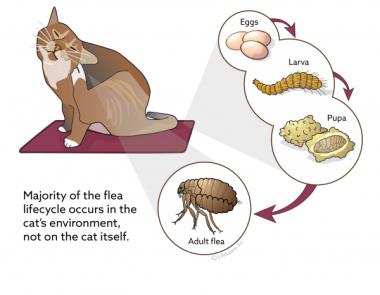The Flea Life Cycle
Understanding the flea life cycle helps in planning appropriate environmental controls.
Fleas are living outside in upstate New York during the non-frost, growing season. Once, this period was mid-May to late October, but now varies depending on the weather for that year! Warmer parts of the country may have a year-long flea season, like Florida. Any pet that goes outside is going to attract the fleas while outside and potentially carry them to indoor areas. Clearly, some neighborhoods have heavy local loads (see fleas every year) and others have light local loads (may not see fleas every year). But if you have pets, at sometime you are going to have fleas.
Prevention controls include using topical preventions (Vectra, Bravecto, or other flea killing products) regularly to kill the fleas that jump on the pet thereby protecting the pet and keeping the fleas from establishing an indoor population. Other prevention products, like Capstar, work by giving daily medication but we consider them less effective than the topicals. Older preventions like baths, are very ineffective (you would have to bath the pet every 2 or so days for them to work- not humanly possible!).
Fleas are small, brown, oval, fast moving insects that bite the pet to feed on blood, and lay eggs in the environment. Fleas can jump on and off multiple feeding sources (pets, owners, wildlife) for multiple bites during its lifespan. The eggs are virtually invisible, but roll into corners, cracks and can persist for long periods of time until hatching. They hatch into TINY larvae (worms/caterpillars) that can sometimes be seen on pet bedding or sleeping areas if present in large numbers. These larvae spin a cocoon and live as a pupa in the environment. In this protected sac, fleas can survive in environments for months, waiting for the right time to hatch into fleas. It is common for mass hatchings to occur when an unoccupied indoor space (apartment, home) is suddenly reoccupied (after new rental, after vacation).
Controlling an infestation is POSSIBLE. It will take work and weeks or months to fully control the infestation, depending on the level of infestation and the number of pets and the type of control. Washing bedding and thorough vacuuming quickly and safely remove 50-70% of the flea population, but other treatments are needed to fully remove the flea population from the home environment.
Lower pesticide infestation control takes longer to regain control and is potentially more expensive, dependent on the number of pets involved. The pesticides are used only on the pet, and not in the home. The monthly topicals, Vectra, Bravecto, have to be applied consistently and well for 6-12 months to clean the environment by killing the fleas after they have gotten on the pet. They have to be applied during the winter as well, since the fleas have established a foothold in the home environment.
Higher pesticide infestation control is quicker and potentially less expensive, but requires pesticide use in the home environment. Monthly topical pesticides, Vectra, Bravecto, Nexgard, and Credelio, still have to be applied to the pets until control is regained. Appropriate sprays like Siphotrol, pesticide and hormonal insect controls, are used in the home for quick removal of environmental fleas, eggs and larvae. Siphotrol can be purchased from your veterinarian or reception staff. One container treats 2,000 square feet of home environment and costs less than $30. Professionals like Orkin and Cat's Eye can also help reestablish control of infestations using very similar products.
How do you tell the infestation is gone? You will want to not see fleas on the pets (or people) for extended periods of time before you celebrate! A flea comb is your best indicator of control.
Once you have successfully obliterated a flea infestation, you can breathe a sigh of relief. But be aware, fleas may still thrive outside with consecutive days that have above freezing temperatures. At this point, prevention controls (Nexgard, Vectra, Bravecto, Revolution, Seresto) are going to be worth consistent year-round use!
Back to FAQs


